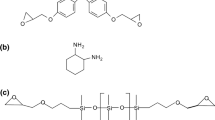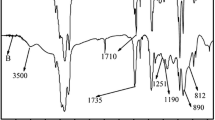Abstract
Toughening of a diglycidyl ether of bisphenol-A (DGEBA)-based epoxy resin with liquid carboxyl-terminated butadiene acrylonitrile (CTBN) copolymer has been investigated. For this purpose six blend samples were prepared by mixing DGEBA with different concentrations of CTBN from 0 to 25 phr with an increment of 5 phr. The samples were cured with dicyandiamide curing agent accelerated by Monuron. The reactions between oxirane groups of DGEBA and carboxyl groups of CTBN were followed by Fourier-transform infrared (FTIR) spectroscopy. Tensile, impact, fracture toughness and dynamic mechanical analysis of neat as well as the modified epoxies have been studied to observe the effect of CTBN modification. The tensile strength of the blend systems increased by 26 % when 5 phr CTBN was added, and it remained almost unchanged up to 15 phr of CTBN. The elongation-at-break and Izod notched impact strength increased significantly, whereas tensile modulus decreased gradually upon the addition of CTBN. The maximum toughness of the prepared samples was achieved at optimum concentration of 15 phr of CTBN, whereas the fracture toughness (K IC) remained stable for all blend compositions of more than 10 phr of CTBN. The glass transition temperature (T g) of the epoxy resin significantly increased (11.3 °C) upon the inclusion of 25 phr of CTBN. Fractured surfaces of tensile test samples have been studied by scanning electron microscopic analysis. This latter test showed a two-phase morphology where the rubber particles were distributed in the epoxy resin with a tendency towards co-continuous phase upon the inclusion of 25 phr of CTBN.















Similar content being viewed by others
References
Thomas R, Boudenne A, Ibos L, Candau Y, Thomas S (2010) Thermophysical properties of CTBN and HTPB liquid rubber modified epoxy blends. J Appl Polym Sci 116:3232–3241
Kaynak C, Arikan A, Tincer T (2003) Flexibility improvement of short glass fiber reinforced epoxy by using a liquid elastomer. Polymer 44:2433–2439
Tripathi G, Srivastava D (2009) Cure kinetics of ternary blends of epoxy resins studied by nonisothermal DSC data. J Appl Polym Sci 112:3119–3126
Ramos VD, Costa HM, Soares VLP, Nascimento RSV (2005) Modification of epoxy resin: a comparison of different types of elastomer. Polym Test 24:387–394
Tripathi G, Srivastava D (2008) Studies on the physico-mechanical and thermal characteristics of blends of DGEBA epoxy, 3,4 epoxy cyclohexylmethyl, 3′,4′-epoxycylohexane carboxylate and carboxyl terminated butadiene co-acrylonitrile (CTBN). Mater Sci Eng A 496:483–493
Liu K, Lu S, Li S, Huang B, Wei C (2012) Mechanical and thermal properties of POSS-g-GO reinforced epoxy composites. Iran Polym J 21:497–503
Tripathi G, Srivastava D (2009) Toughened cycloaliphatic epoxy resin for demanding thermal applications and surface coatings. J Appl Polym Sci 114:2769–2776
Thomas R, Durix S, Sinturel C, Omonov T, Goossens S, Groeninckx G, Moldenaers P, Thomas S (2007) Cure kinetics, morphology and miscibility of modified DGEBA-based epoxy resin—Effects of a liquid rubber inclusion. Polymer 48:1695–1710
Lu S, Ban J, Yu C, Deng W (2010) Properties of epoxy resins modified with liquid crystalline polyurethane. Iran Polym J 19:669–678
Thomas R, Yumei D, Yuelong H, Le Y, Moldenaers P, Weimin Y, Czigany T, Thomas S (2008) Miscibility, morphology, thermal, and mechanical properties of a DGEBA based epoxy resin toughened with a liquid rubber. Polymer 49:278–294
Ma SQ, Liu WQ, Hu CH, Wang ZF (2010) Modification of epoxy resins with polyether-g-polysiloxanes. Iran Polym J 19:185–196
Shukla SK, Srivastava D (2006) Blends of modified epoxy resin and carboxyl-terminated polybutadiene. J Appl Polym Sci 100:1802–1808
Tripathi G, Srivastava D (2007) Effect of carboxyl-terminated poly(butadiene-co-acrylonitrile) (CTBN) concentration on thermal and mechanical properties of binary blends of diglycidyl ether of bisphenol-A (DGEBA) epoxy resin. Mater Sci Eng A 443:262–269
Lee HB, Kim HG, Yoon KB, Lee DH, Min KE (2009) Preparation and properties of a carboxyl-terminated butadiene acrylonitrile toughened epoxy/montmorillonite nanocomposite. J Appl Polym Sci 113:685–692
Yadav R, Srivastava D (2009) The effect of CTBN concentrations on the kinetic parameters of decomposition of blends of cardanol-based epoxidized novolac resin modified with carboxyl-terminated liquid copolymer. J Appl Polym Sci 114:1694–1701
Yadav R, Srivastava D (2009) Synthesis and properties of cardanol-based epoxidized novolac resins modified with carboxyl-terminated butadiene–acrylonitrile copolymer. J Appl Polym Sci 114:1670–1681
Yadav R, Srivastava D (2009) Toughened cycloaliphatic epoxy resin for demanding thermal applications and surface coatings. J Appl Polym Sci 114:2769–2776
Chenab WS, Changa YL, Hsianga HI, Hsua FC, Shena YH, Yena FS (2011) Mechanical and dielectric properties of NiZn ferrite powders-CTBN modified epoxy resin coatings. Polym-Plast Technol Eng 50:568–572
Verchere D, Sautereau H, Pascault JP (1990) Rubber-modified epoxies: I. Influence of carboxyl-terminated butadiene-acrylonitrile random copolymers (CTBN) on the polymerization and phase separation processes. J Appl Polym Sci 41:467–485
Wise CW, Cook WD, Goodwin AA (2000) CTBN rubber phase precipitation in model epoxy resins. Polymer 41:4625–4633
Poornima Vijayan P, Puglia D, Jyotishkumar P, Kenny JM, Thomas S (2012) Effect of nanoclay and carboxyl-terminated (butadiene-co-acrylonitrile) (CTBN) rubber on the reaction induced phase separation and cure kinetics of an epoxy/cyclic anhydride system. J Mater Sci 47:5241–5253
Kavitha, Revathi A, Rao S, Srihari S, Dayananda GN (2012) Characterization of shape memory behaviour of CTBN-epoxy resin system. J Polym Res 19:9894–9901
Poisson N, Maazouz A, Sautereau H, Taha M, Gambert X (1998) Curing of dicyandiamide epoxy resins accelerated with substituted ureas. J Appl Polym Sci 69:2487–2497
Hong SG, Lin JJ (1996) Effects of DICY content and metal oxide on the curing behavior of a brominated epoxy resin. J Appl Polym Sci 59:1597–1605
Ivanova KI, Pethrick RA, Affrossman S (2001) Hygrothermal aging of rubber-modified and mineral-filled dicyandiamide-cured DGEBA epoxy resin: II. Dynamic mechanical thermal analysis. J Appl Polym Sci 82:3477–3485
Jackson ML, Love BJ (2004) Dicyandiamide precipitation in epoxy solutions and latex dispersions: threshold concentration analysis using a two-stage drying model. Polymer 45:7229–7238
Wang Q, Storm BK, Houmøller LP (2003) Study of the isothermal curing of an epoxy prepreg by near-infrared spectroscopy. J Appl Polym Sci 87:2295–2305
Gaukler JC, Müller U, Krüger JK, Possart W (2011) Functional nano fillers in epoxy-dicyandiamide adhesives for prolonged shelf life and efficient cure. e-Polymers 10:1–15
Hagnauer GL, Dunn DA (1981) Dicyandiamide analysis and solubility in epoxy resins. J Appl Polym Sci 26:1837–1846
Dreerman E, Narkis M, Siegmann A, Joseph R, Dodiuk H, Dibenedetto AT (1999) Mechanical behavior and structure of rubber modified vinyl ester resins. J Appl Polym Sci 72:647–657
Pramanik M, Mendon SK, Rawlins JW (2012) Determination of epoxy equivalent weight of glycidyl ether based epoxides via near infrared spectroscopy. Polym Test 31:716–721
Huang Y, Kinloch AJ (1992) The toughness of epoxy polymers containing microvoids. Polymer 33:1330–1332
Saadati P, Baharvand H, Rahimi A, Morshedian J (2005) Effect of modified liquid rubber on increasing toughness of epoxy resins. Iran Polym J 14:637–646
Kishi H, Naitou T, Matsuda S, Murakami A, Muraji Y, Nakagaw Y (2007) Mechanical properties and inhomogeneous nanostructures of dicyandiamide-cured epoxy resins. J Appl Polym Sci 45:1425–1434
Author information
Authors and Affiliations
Corresponding author
Rights and permissions
About this article
Cite this article
Akbari, R., Beheshty, M.H. & Shervin, M. Toughening of dicyandiamide-cured DGEBA-based epoxy resins by CTBN liquid rubber. Iran Polym J 22, 313–324 (2013). https://doi.org/10.1007/s13726-013-0130-x
Received:
Accepted:
Published:
Issue Date:
DOI: https://doi.org/10.1007/s13726-013-0130-x




